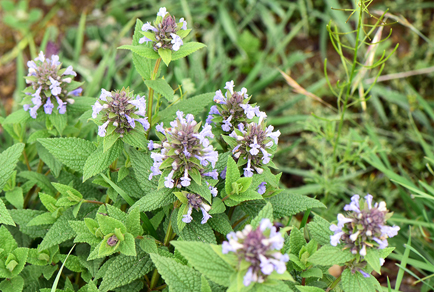Abstract
As currently circumscribed, the genus Dracocephalum Linnaeus (1753: 594) includes the traditionally defined Hyssopus Linnaeus (1753: 569) and Lallemantia Fischer & Meyer (1840: 52), making it the second largest genus in subtribe Nepetinae (Nepetoideae, Lamiaceae), consisting of ca. 80 species (Chen et al. 2022). Morphologically, the genus is most similar to Nepeta Linnaeus (1753: 570), but it can be easily distinguished from the latter by its calyces with a thickened sinus-like fold between the bases of adjacent calyx lobes (Li & Hedge 1994; Harley et al. 2004). There are approximately 40 species of Dracocephalum distributed in China, of which 19 are endemic (Li & Hedge 1994; Chen et al. 2021, 2022). Among those endemic species, Dracocephalum breviflorum Turrill (1922: 154) was described on the basis of a specimen collected from Mount Everest area, southern Xizang (Tibet), China (A.F.R. Wollaston 255, K000911317). In the protologue, Turrill (1922) thought D. breviflorum is most similar to D. heterophyllum Bentham (1835: 738) but emphasized that the calyx morphology of the species (i.e., remarkably short and more distinctly 2-lipped than any previously known species of Dracocephalum) is unique in Dracocephalum. During our taxonomic revision of Dracocephalum in the Pan-Himalayan region, we found that D. breviflorum does not have a thickened sinus-like fold between the base of the calyx lobes, indicating it should be a member of the genus Nepeta. Given the importance of types in solving taxonomical issues (Wagensommer et al. 2016; Akhil et al. 2022; Perrino et al. 2023), we carefully compared the type specimens of both D. breviflorum and Nepeta coerulescens Maximowicz (1881: 529) (Fig. 1). In addition, we carried out observations of plants in the field (Fig. 2). The results of our research on herbarium specimens and in the field demonstrated that D. breviflorum and N. coerulescens are conspecific, and here we synonymize Dracocephalum breviflorum under Nepeta coerulescens.
References
- Akhil, M.K., Möller, M. & Nampy S. (2022) Lectotypifications of four names in the family Gesneriaceae. Adansonia 44 (3): 15–21. https://doi.org/10.5252/adansonia2022v44a3
- Bentham, G. (1835) Labiatarum Genera et Species. Fascicle 7. J. Ridgeway & Sons, London.
- Chen, Y.P., Chen, Y.S. & Xiang, C.L. (2021) Dracocephalum microphyton (Lamiaceae: Nepetoideae), a new species from south-west China. Kew Bulletin 76: 287–292. https://doi.org/10.1007/s12225-021-09933-8
- Chen, Y.P., Turdimatovich, T.O., Nuraliev, M.S., Lazarević, P., Drew, B.T. & Xiang, C.L. (2022) Phylogeny and biogeography of the northern temperate genus Dracocephalum s.l. (Lamiaceae). Cladistics 38: 429–451. https://doi.org/10.1111/cla.12502
- Fischer, F.E.L. & Meyer, C.A. (1840) Index seminum, quae Hortus Botanicus Imperialis Petropolitanus pro mutua commutatione offert. Accedunt Animadversiones botanicae nonnullae 6: 52. Petropoli. [Index Sem. Hort. Petrop. 6: 52].
- Harley, R.M., Atkins, S., Budantzev, A.L., Cantino, P.D., Conn, B.J., Grayer, R., Harley, M.M., de Kok, R., Krestovskaja, T., Morales, R., Paton, A.J., Ryding, O. & Upson, T. (2004) Labiatae. In: Kubitzki, K. & Kadereit, J.W. (Eds.) The families and genera of vascular plants, vol. 7. Springer, Berlin, Heidelberg, pp. 167–275. https://doi.org/10.1007/978-3-642-18617-2_11
- Li, H.W. & Hedge, I.C. (1994) Dracocephalum Linnaeus. In: Wu, Z.Y. & Raven, P.H. (Eds.) Flora of China vol. 17. Science Press, Beijing & Missouri Botanical Garden Press, St. Louis, pp. 124–133.
- Linnaeus, C. (1753) Species Plantarum. Laurentii Salvii, Holmiae.
- Maximowicz, C.J. (1881) Diagnoses plantarum novarum asiaticarum. IV. Bulletin de l’Académle Impériale des Sciences de St.-Pétersbourg 27: 425–460.
- Perrino, E.V., Mahmoud, Z.N.A., Valerio, F., Tomaselli, V., Wagensommer, R.P. & Trani, A. (2023) Synecology of Lagoecia cuminoides L. in Italy and evaluation of functional compounds presence in its water or hydroalcoholic extracts. Scientific Reports 13: 20906. https://doi.org/10.1038/s41598-023-48065-w
- Thiers, B. (2024) Index Herbariorum: A global directory of public herbaria and associated staff. New York Botanical Garden’s Virtual Herbarium. Available from: http://sweetgum.nybg.org/science/ih/ (accessed 19 January 2024)
- Turrill, W.B. (1922) in Anonymous, New species from Mount Everest. Bulletin of Miscellaneous Information, Royal Gardens, Kew 1922 (4): 149–155. https://doi.org/10.2307/4120205
- Wagensommer, R.P., Perrino, E.V., Albano, A., Medagli, P. & Passalacqua, N.G. (2016) Lectotypification of four Lacaita’s names in the genus Centaurea (Asteraceae). Phytotaxa 269 (1): 54–58. https://doi.org/10.11646/phytotaxa.269.1.7


